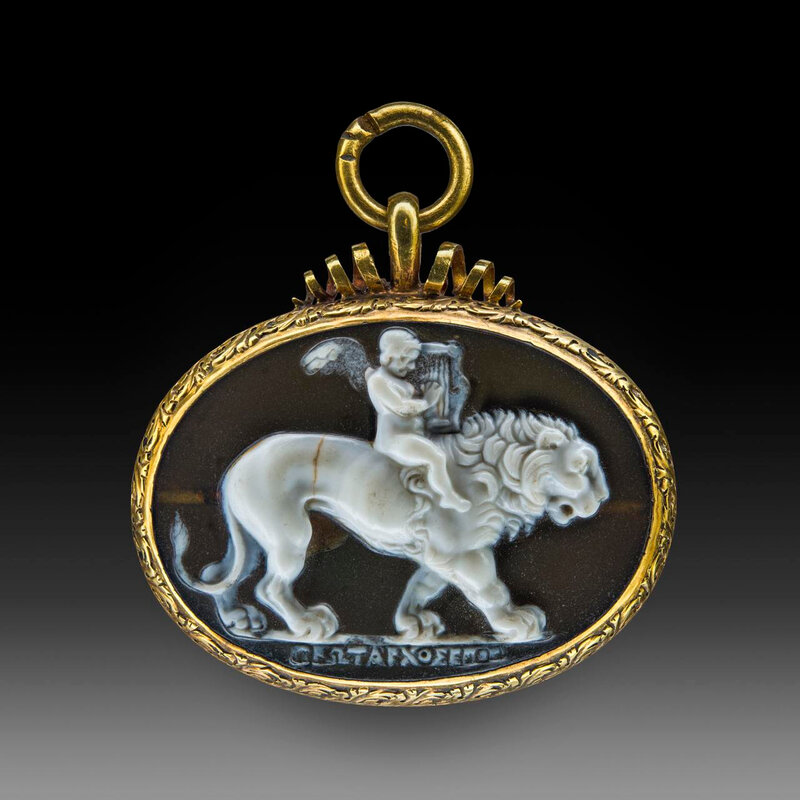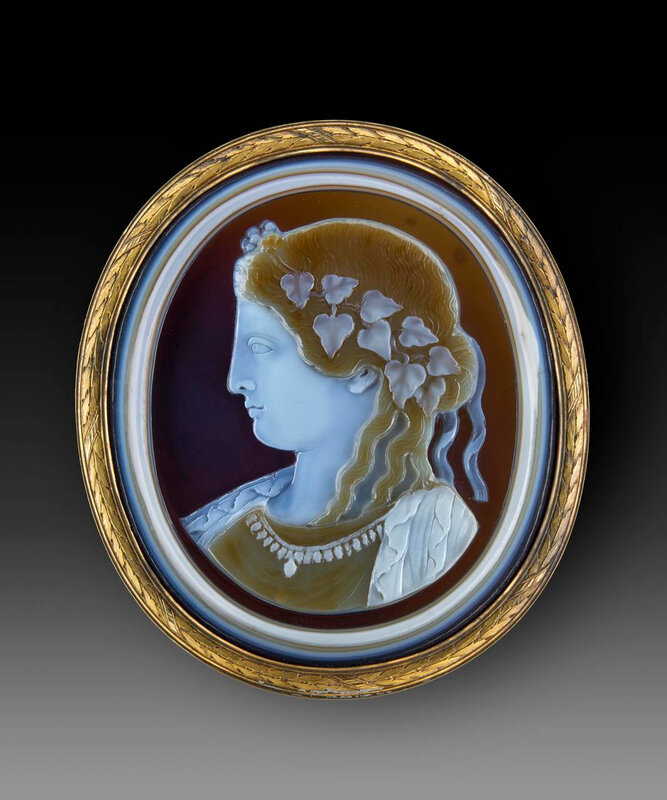Historic Medici and Lorraine Gem Collection on view for the first time
Photo: Fernando Guerrini Archaeological Superintendence of Tuscany.
FLORENCE.- The newly refurbished section displaying the extraordinary collection of antique gems collected by the Medici and Lorraine families opened at the National Archeological Museum in Florence last month, enabling the display of a selection of objects for the first time. The last ruling dynasties of the Duchy of Florence, the Medici and Lorraine families collected the diminutive masterpieces—Babylonian, Greek, Etruscan, Roman, and post-Classical—dating from 2300 B.C. to the early 18th century. Friends of Florence Foundation funding supported the two years of study and preparatory work, the refurbishment of the gallery, new display cases, and interpretive material including touch-screens to showcase one of the largest and most important gem collections in the world. The first display in what will be ongoing rotating installations includes 432 objects from the over 2,300 pieces in the collections.
Hermaphroditus. Last quarter 1st century B.C. (cameo). Late 16th - early 17th centuries (mount). Sardonyx, gold, enamel, garnets, emeralds. Inv. n. 14464. From the collection of Leonardo Agostini, Rome; then collection of Cardinal Leopoldo de’ Medici. photo by Fernando Guerrini.
Stefano Casciu, Director of the Polo Museale della Toscana; Mario Iozzo, Director of the Museo Archeologico Nazionale in Florence, and Simonetta Brandolini d’Adda, President of Friends of Florence opened the section in a ceremony on December 14, 2018.
The new gallery space is sited in a corridor in the museum, formerly the Palazzo della Crocetta commissioned by Cosimo II de’ Medici (1590-1621) for his sister, Princess Maria Maddalena (1600-33). Between 1619 and 1620, the architect Giulio Parigi built the Palazzo with the corridor that connects it to the basilica of the SS. Annunziata. The corridor ends in the private tribune, called the Corretto, where the princess, who was born with disfigurements, could attend Mass unseen by others.
photo by Fernando Guerrini.
Riccardo Gennaioli (now an official of the Opificio delle Pietre Dure) began studying, cataloguing, and selecting the pieces in 2016. The current display features all types of gems collected by members of the two dynasties: ancient seals, cameos, intaglios, glass paste, “magical” gems, and rings made of chalcedony, sardonyx, carnelian, sapphire, and garnet—the most prized stones of antiquity. While many are in their original, Roman-period mounts, others are in ornate frames and settings made during the Renaissance.
Stefano Casciu said, "We are so pleased to have the invaluable cooperation with Friends of Florence continuing with this new display of the Medici-Lorraine gem collection and confirm the Foundation’s friendship with us. This is a fine example of public-private cooperation, working to protect and enhance the cultural heritage of our museums. Once again, Friends of Florence has supported public partners—the Polo Museale della Toscana and the Museo Archeologico Nazionale—through the enormous generosity of American donors who express their love and respect for the works of art, the collections, and especially the skills and knowledge of those who work in our museums. My heartfelt thanks to Friends of Florence, to the President Simonetta Brandolini d'Adda, to the American donors, and to all who contributed to the success of this major project."
Bust of a bacchant or Dionysus. First half 1st century B.C. (cameo). 17th century (mount). Sardonyx, gold. Inv. n. 14504. photo by Fernando Guerrini.
“Friends of Florence is delighted to support this important project and bring this significant and unique collection back to light,” said Simonetta Brandolini d’Adda, co-founder and president of the Foundation. “The ancient gems that had belonged to the Medici and Lorraine families can now be seen by the public and scholars in a new setting that allows them to become acquainted with a group of artistic items of immense historical value and rare beauty. We are grateful to our donors, Martha and David Slosburg and The Jay Pritzker Foundation, for their enlightened generosity to Florence and its treasures that made this project possible.
The exhibition setting, conceived and directed by Mario Iozzo, was designed by architect Gigi Cupellini with the cooperation of Carlo Pellegrini. The installation was overseen by Galli Allestimenti, with graphics by Stampa in Stampa (Claudio Chiarusi) and lighting by Atlas and Livelux (Alessandro Caloia and Alessandro Martini) and Tiziano Manzini Impianti Elettrici.
Hercules holding a female figure for her dress. 1st century B.C. (?). Second half 17th century (mount). Chalcedony, gold, silver, enamel, diamonds, rubies (or garnets). Inv. n. 14451. photo by Fernando Guerrini.
The Collection
Lorenzo Medici the Magnificent (1449-92) purchased some pieces from the superb collection of Venetian Cardinal Pietro Barbo (1417-71) who would later become Pope Paul II. Over the centuries, the collection was increased by Cosimo I and his wife Eleonora de Toledo, Cardinal Leopoldo de’ Medici (the “prince of collectors”), Gian Gastone de’ Medici and his sister the Electress Palatine Anna Maria Luis de’ Medici, and Pietro Leopoldo of Habsburg-Lorraine. It was Anna Maria Luisa who left all of the Medici Collections to Florence in her will. The house of Lorraine ruled the Grand Duchy of Florence when the last Medici, Gian Gastone, died in 1737 without an heir. Lorraine rule ended when Florence was annexed to the Italian kingdom in 1860.
Some of the gems in fine gold mounts decorated with enamel and precious stones are considered among the most beautiful examples of settings for non-religious jewels from the Renaissance and several are attributed to Benvenuto Cellini (1500-71) and his workshop.
photo by Fernando Guerrini.
An anteroom, created by architects Simone Martini and Chiara Fornari of Studio Machina, features panels of photographs, touch-screens, videos, and films produced by Marcello Fittipaldi and Davide Morena of Sideways, with texts by Stefania Berutti. The room offers visitors an introduction to the exhibition area and the Medici Palazzo della Crocetta and the corridor, a cloistered hallway built for Maria Maddalena’s personal use and originally decorated with the Stations of the Cross. Images on the touch-screens allow visitors to examine the gems and amazing craftsmanship in detail. The captions offer in-depth information about the materials, subjects depicted, history of the collection, and the early owners who, by purchasing these precious cameos and intaglios, not only promoted a learned approach to collecting but also augmented their personal prestige by wearing them as ornaments.
Additional touch-screens, wall text, and videos tell the story of the Medici princess, the corridor, and the decorations of the Corretto that have remained unchanged since 1620. All texts are in Italian and English.
photo by Fernando Guerrini.
photo by Fernando Guerrini.
photo by Fernando Guerrini.
photo by Fernando Guerrini.
photo by Fernando Guerrini.
photo by Fernando Guerrini.
photo by Fernando Guerrini.

/https%3A%2F%2Fprofilepics.canalblog.com%2Fprofilepics%2F1%2F0%2F100183.jpg)
/https%3A%2F%2Fstorage.canalblog.com%2F03%2F02%2F119589%2F96711876_o.jpg)
/https%3A%2F%2Fstorage.canalblog.com%2F11%2F31%2F119589%2F94773502_o.jpg)
/https%3A%2F%2Fstorage.canalblog.com%2F20%2F83%2F119589%2F94772815_o.jpg)
/https%3A%2F%2Fstorage.canalblog.com%2F26%2F72%2F119589%2F75604929_o.jpg)
/https%3A%2F%2Fstorage.canalblog.com%2F59%2F60%2F119589%2F26458628_o.jpg)
















/image%2F1371349%2F20240416%2Fob_65a1d8_telechargement-31.jpg)
/image%2F1371349%2F20240416%2Fob_3b1c51_telechargement.jpg)
/image%2F1371349%2F20240416%2Fob_2a8420_437713933-1652609748842371-16764302136.jpg)
/image%2F1371349%2F20240416%2Fob_3f6edc_438868891-1652442212192458-70192626099.jpg)